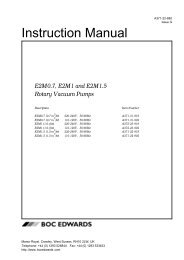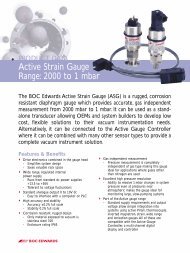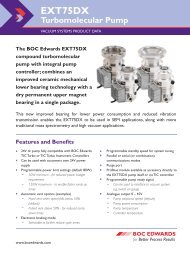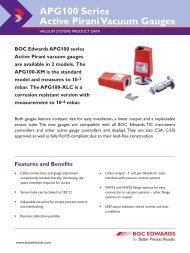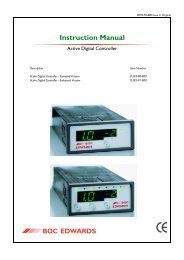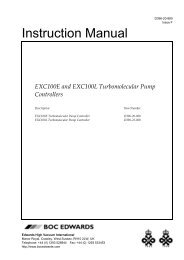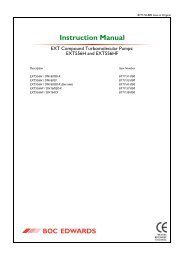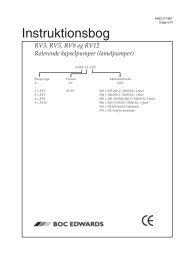Instr Manual: E2M28 and E2M30 Rotary Vacuum Pumps - en
Instr Manual: E2M28 and E2M30 Rotary Vacuum Pumps - en
Instr Manual: E2M28 and E2M30 Rotary Vacuum Pumps - en
Create successful ePaper yourself
Turn your PDF publications into a flip-book with our unique Google optimized e-Paper software.
<strong>E2M28</strong> <strong>and</strong> <strong>E2M30</strong> <strong>Rotary</strong> <strong>Vacuum</strong> <strong>Pumps</strong><br />
4.1.3 Gas purges<br />
PAGE<br />
24<br />
OPERATION<br />
WARNING<br />
If you use inert gas purges to dilute dangerous gases to a safe level, <strong>en</strong>sure that the pump<br />
is shut down if an inert gas supply fails.<br />
WARNING<br />
You must obey the instructions <strong>and</strong> take note of the precautions giv<strong>en</strong> below, to <strong>en</strong>sure<br />
that pumped gases do not <strong>en</strong>ter their flammable ranges.<br />
Switch on the inert gas purge to remove air from the pump <strong>and</strong> the exhaust pipeline before the process<br />
starts. Switch off the purge flow at the <strong>en</strong>d of the process only after any remaining flammable gases or<br />
vapours have be<strong>en</strong> purged from the pump <strong>and</strong> exhaust pipeline.<br />
If liquids that produce flammable vapours could be pres<strong>en</strong>t in the pump foreline, th<strong>en</strong> the inert gas purge<br />
to the pump should be left on all the time this liquid is pres<strong>en</strong>t. Flammable liquids could be pres<strong>en</strong>t in the<br />
foreline as a result of cond<strong>en</strong>sation, or may be carried over from the process.<br />
Wh<strong>en</strong> you calculate the flow rate of inert gas required for dilution, consider the maximum flow rate for<br />
the flammable gases/vapours that could occur. For example, if a mass flow controller is used to supply<br />
flammable gases to the process, you should assume a flow rate for flammable gases that could arise if the<br />
mass flow controller is fully op<strong>en</strong>.<br />
Continually measure the inert gas purge flow rate: if the flow rate falls below that required, you must<br />
stop the flow of flammable gases or vapours into the pump.<br />
Note:<br />
We recomm<strong>en</strong>d that you obtain <strong>and</strong> read the <strong>Vacuum</strong> Pump <strong>and</strong> <strong>Vacuum</strong> System Safety manual<br />
(publication number P300-20-000), available from BOC Edwards or your supplier.<br />
4.2 Gas-ballast control<br />
Use the gas-ballast control (Figure 1, item 3) to change the flow of gas-ballast into the low vacuum stage<br />
of the pump, <strong>and</strong> to provide an additional oil-feed to the pump mechanism.<br />
Use the gas-ballast control closed:<br />
• To achieve ultimate vacuum.<br />
• To pump dry gases.<br />
Turn the gas-ballast control six turns anti-clockwise to op<strong>en</strong> it fully. Use the gas-ballast control op<strong>en</strong>:<br />
• To pump high conc<strong>en</strong>trations of cond<strong>en</strong>sable vapour.<br />
• To decontaminate the oil.<br />
Wh<strong>en</strong> you operate the pump with the gas-ballast control op<strong>en</strong>, there will be an increased rate of oil loss<br />
from the pump. Ideally, a mist filter <strong>and</strong> oil return kit should be used on clean applications.<br />
Issue K 24 Jul 05



